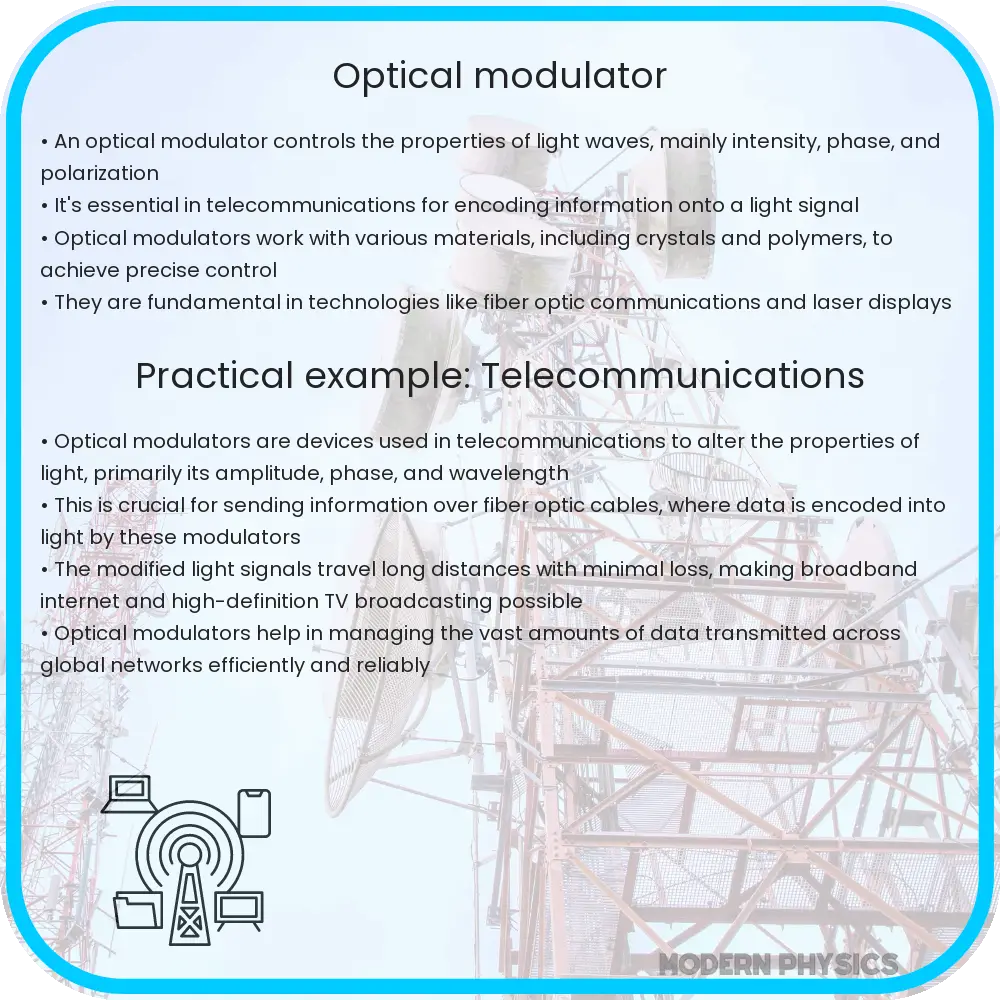Explore the world of optical modulators in photonics, covering high-speed, precision modulation and integration in modern communication systems.

Understanding Optical Modulators: High-Speed, Precision, and Integration
An optical modulator is a critical component in the realm of photonics and optical communications, playing a pivotal role in manipulating light to encode information. This article delves into the nuances of high-speed, precision optical modulators and their integration into modern technology systems.
Principles of Optical Modulation
At its core, an optical modulator functions by altering the properties of light, such as its amplitude, phase, or frequency, to convey data. This modulation can be achieved through various mechanisms, including electro-optic, acousto-optic, or magneto-optic effects. The choice of modulation technique depends on the application’s requirements for speed, efficiency, and environmental stability.
High-Speed Modulation for Advanced Communications
In high-speed optical communication systems, the demand for faster data transmission has led to the development of advanced modulators capable of operating at speeds of tens to hundreds of gigabits per second (Gbps). These devices are crucial in fiber optic networks, where they enable the rapid transfer of vast amounts of data over long distances with minimal signal degradation.
Precision and Efficiency in Modulator Design
Precision in optical modulation is paramount for maintaining signal integrity and reducing errors in data transmission. Advanced materials and design techniques have enabled the creation of modulators with precise control over the light’s properties. For instance, Lithium Niobate (LiNbO3) modulators offer exceptional precision due to their high electro-optic coefficients and low optical losses.
Integration with Photonic and Electronic Systems
The integration of optical modulators into photonic and electronic systems is a critical aspect of modern technology. Integrated photonic circuits, which combine optical components on a single chip, benefit from compact, efficient modulators. Silicon photonics, in particular, has emerged as a promising platform for integrating optical modulators with electronic circuits, offering advantages in terms of scalability, cost, and compatibility with existing semiconductor fabrication processes.
Such integration is not without challenges, as it requires careful consideration of factors like thermal management, power consumption, and compatibility with electronic drivers. Nonetheless, integrated optical modulators are paving the way for more compact, energy-efficient, and high-speed optical communication systems.
As we move forward, the development of optical modulators will continue to be driven by the need for higher speeds, greater precision, and seamless integration with electronic systems. These advancements will undoubtedly play a significant role in shaping the future of optical communications and photonics technology.
Emerging Technologies in Optical Modulation
The field of optical modulation is witnessing rapid advancements with emerging technologies that promise to revolutionize communication systems. One such technology is the use of photonic crystals in modulators. These structures allow for the manipulation of light at a scale much smaller than the wavelength, enabling ultra-compact modulators with potentially faster response times and lower power consumption.
Another area of innovation is in the development of plasmonic modulators. These devices utilize the interaction of light with free electrons on a metal’s surface, offering a path to modulators that are not only smaller but also capable of operating at extremely high frequencies.
Challenges and Future Directions
Despite the exciting progress, challenges remain in the field of optical modulation. One significant hurdle is the integration of optical modulators into existing electronic and photonic systems without compromising performance. Additionally, as data transmission rates continue to increase, managing the power consumption and heat dissipation of modulators becomes more critical.
Future research is likely to focus on addressing these challenges while pushing the boundaries of speed and miniaturization. The exploration of new materials, such as two-dimensional materials like graphene, may offer breakthroughs in modulator performance and integration capabilities.
Conclusion
In conclusion, optical modulators are at the heart of modern communication systems, offering the ability to control light with precision and speed. The advancements in high-speed, precision modulation and integration with photonic and electronic systems have been instrumental in the evolution of optical communications. As we look ahead, emerging technologies like photonic crystals and plasmonic modulators are set to further enhance the capabilities of these devices. However, overcoming the challenges of integration, power management, and thermal effects remains critical for future developments. With ongoing research and innovation, optical modulators will continue to play a pivotal role in shaping the landscape of communication and photonics technology, driving us towards an increasingly connected and high-speed digital world.
